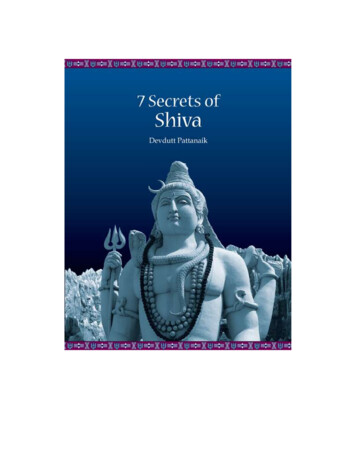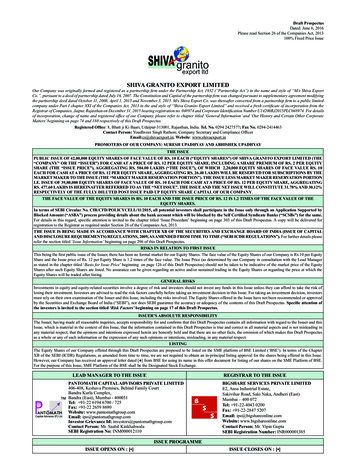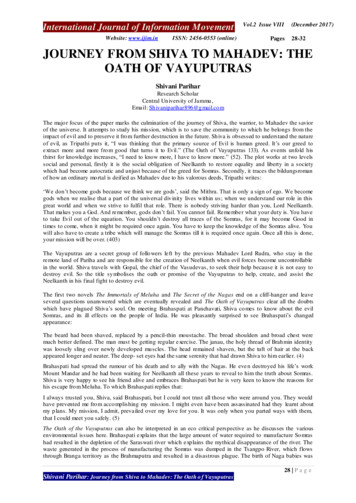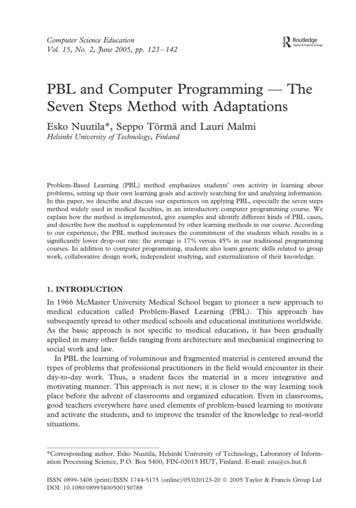
Transcription
7 SECRETS OFSHIVADevdutt Pattanaik is a medical doctor by education, a leadershipconsultant by profession, and a mythologist by passion. He writesand lectures extensively on the relevance of stories, symbols andrituals in modern life. He has written over fifteen books whichinclude 7 Secrets of Hindu Calendar Art (Westland), Myth Mithya: AHandbook of Hindu Mythology (Penguin), Book of Ram (Penguin), Jaya:An Illustrated Retelling of the Mahabharata (Penguin).To know more visit devdutt.com
7 Secrets ofShivaDevdutt Pattanaik
westland ltdVenkat Towers, 165, P.H. Road, Maduravoyal, Chennai 600 095No. 38/10 (New No.5), Raghava Nagar, New Timber Yard Layout, Bangalore 560 026Survey No. A - 9, II Floor, Moula Ali Industrial Area, Moula Ali, Hyderabad 500 04023/181, Anand Nagar, Nehru Road, Santacruz East, Mumbai 400 0554322/3, Ansari Road, Daryaganj, New Delhi 110 002First published by westland ltd 2011Copyright Devdutt Pattanaik 2011All Rights Reserved10 9 8 7 6 5 4 3 2 1ISBN: 978-93-80658-63-6Typeset and designed by Special Effects, MumbaiPrinted at Thomson Press (India) Ltd.This book is sold subject to the condition that it shall not by way of trade or otherwise, belent, resold, hired out, circulated, and no reproduction in any form, in whole or in part(except for brief quotations in critical articles or reviews) may be made without writtenpermission of the publishers.
I humbly and most respectfully dedicate this book tothose hundreds of artists and artisans who madesacred art so easily accessible to the common man
ContentsAuthor’s Note: On Context and Structure1. Lingeshwara’s Secret2. Bhairava’s Secret3. Shankara’s Secret4. Bholenath’s Secret5. Ganesha’s Secret6. Murugan’s Secret7. Nataraja’s SecretAcknowledgements
Author’s NoteOn Context and StructureImagine a Western scholar. He, or she, is typically from Europe orAmerica. All his life, he has been exposed to Judaism,Christianity or Islam, religions that frown upon any overtdisplay of sexuality. To him, sexuality is almost always an act ofrebellion, an expression of defiance against the establishment. It isseen as being modern.So imagine his surprise when he comes to India andencounters temples embellished with images of men and women inerotic embrace. Imagine his bewilderment when he finds Hindusworshipping an image shaped like a phallus called Shiva-linga. Thisis what his ancestors, a hundred years ago, also encountered, andcondemned as pre-modern, licentious and savage. The scholar findsthem vicariously liberating. Keen to study and understand theseimages, he hunts for a suitable academy. He finds none in India. Sohe enrols in a Western institution, where he is guided by Westernacademicians and is expected to follow methodologies developedand approved in the West. He starts reading texts as he would readthe Bible, not realising that texts do not serve the same purpose inHinduism. He decodes scriptures and images using his own culturalframeworks as the template. His conclusions are published inrespected academic papers that win him accolades from Westernacademia, but they discomfort, even horrify, the average Hindudevotee.Most Hindus become defensive and, like their 19th-centuryancestors, go out of their way to strip Hinduism of its sexualheritage. A few, especially those with political leanings, reactviolently, outraged by the conclusions. Accused of culturalinsensitivity, Western scholars strike back saying that Hindus do
not know their own heritage and are still viewing Hinduismthrough the archaic Victorian lens. Battle lines are drawn. They arestill drawn. Who is right, the arrogant academician or the stubborndevotee? It is in this context that I write this book.I have noticed that the divide between Western academiciansand Hindu devotees exists in their relative attention to form andthought. Form is tangible and objective, thought is intangible andsubjective. Western scholars have been spellbound by the sexualform but pay scant regard to the metaphysical thought. In otherwords, they prefer the literal to the symbolic. Hindu devotees, incontrast, are so focused on the metaphysical thought that theyignore, or simply deny, the sexual form. The Western preference forform over thought stems from their cultural preference for theobjective over the subjective. Hindus, on the other hand, are verycomfortable with the subjective, hence can easily overlook form andfocus on thought. This book seeks to bridge this wide gap betweenacademics and practice.The first chapter looks at the meaning of the Shiva-lingabeyond the conventional titillation offered by a phallicsymbolThe second chapter focuses on Shiva’s violent disdain forterritorial behaviour amongst humansThe third and fourth chapters deal with how the Goddess getsShiva to engage with the world out of compassionThe next two chapters revolve around Shiva’s two sons,Ganesha and Murugan, through whom he connects with theworldThe final chapter presents Shiva as the wise teacher whoexpresses wisdom through danceThis book seeks to make explicit patterns that are implicit instories, symbols and rituals of Shiva firm in the belief that:Within Infinite Truths lies the Eternal TruthWho sees it all?
Varuna has but a thousand eyesIndra, a hundredAnd I, only two
Icicle Shiva-lingaCarved Shiva-linga
River stone Shiva-lingaNatural rock formation Shiva-lingaOne day a sculptor was given a rock and asked to carve an imageof God. He tried to imagine a form that would best encapsulateGod. If he carved a plant, he would exclude animals andhumans. If he carved an animal, he would exclude humans andplants. If he carved a human, he would exclude plants and animals.If he carved a male, he would exclude the female. If he carved afemale, he would exclude all males. God, he believed, was thecontainer of all forms. And the only way to create this containerwas by creating no form. Or maybe God is beyond all forms, but aform is needed to access even this idea. Overwhelmed by these
thoughts, the sculptor left the stone as it was and bowed before it.This was the linga, the container of infinity, the form of theformless, the tangible that provokes insight into the intangible.The name given to God was Shiva, which means the pure one,purified of all forms. Shiva means that which is transcendent. Shivameans God who cannot be contained by space or time, God whoneeds no form.Shiva has been visualised as an icicle in a cave in Amarnath,Jammu; as a natural rock formation rising up from the earth, as inBuda Kedar at Tehri, Uttarakhand or Lingaraja, Bhubaneswar,Orissa; as a smooth oval stone from the river bed of Narmadaplaced in a metal trough as in Kashi-Vishwanath, Varanasi; or asculpture of a smooth cylindrical free standing pillar rising up froma leaf-shaped base as in Brihadeshwara, Tanjore or theChandramouleshwara temple at Unkal, Karnataka.In the 12th century, in the land which is now called the stateof Karnataka, lived a man called Basava who encouraged everyoneto worship the formless, limitless divine in the form of a personalimage, the ishta-linga, placed in an amulet and tied around theneck. The ishta-linga had no particular form and reminded Basavaof the formless divine. He believed that by adoration of this ideathrough the formless form of the linga, humans would be able tobreak free from all divisions created by man on the basis of lineage,gender, profession or wealth. He inspired the Lingayat andVirashaiva movements.
Ishta-linga of the LingayatsHand gesture of a dancer showing Linga-mudra
Only humans can conceptualise the idea of infinity. Only humanscan communicate such an abstract idea using various forms such aswords and symbols. This is because humans are blessed withimagination. It is the one thing that separates us humans fromanimals.Humans can imagine because we have a highly developedbrain, the cerebrum, with an especially large frontal lobe. Thisanatomical difference separates us from the rest of nature. So muchso that in Samkhya, the Indian school of metaphysics, humanity orPurusha is seen as being separate from nature or Prakriti. Thisdifference is seen as fundamental in the study of metaphysics.Because humans can imagine, the notion of a reality beyond thesenses, a reality beyond nature, has come into being. Without thecerebrum there would be no imagination, and hence no notion ofGod!In nature, all things have form. Each of these forms is limitedby space and time. To sustain these forms one has to feed and onehas to procreate. Eventually all forms are destroyed and replaced bynew forms. Nature is thus a self-sustaining, predictable wheel ofevents where forms come and go. Only humans can imagine aworld where all these rules are subverted: a world without forms, aworld without limitations, a world without the need for action, orthe obligation to experience a reaction, a transcendental worldbeyond feeding and procreating, creating and destroying, a stillworld, with no restlessness, only serenity, only bliss. In otherwords, humans can imagine a world beyond nature. This idea iscontained in the linga.
A stone Mukha-linga from ElloraBrass masks placed over ShivalingaIn many temples of India, a head or multiple heads are carvedon the linga stone, or a brass mask representing a head covers the
linga-stone. This head is identified with Shiva. It is a reminder ofthe human head that is unique from all other heads in the animalkingdom. It houses the highly developed brain that can imagineand hence forge a path to the divine. This is the very same reasonthat sacred marks are placed on the forehead of devotees: to remindthem of the critical role our brain, hence our imagination, plays indefining our humanity.From imagination comes our vision of the world, our vision ofour future, and most importantly our vision of ourselves, who weare and what we want to be. These visions may have nothing to dowith the reality of the natural world around us. They may beimprovements on what we remember or have been told. It isimagination that makes us realise that we are distinct from nature.In other words, imagination makes us self-aware. It is alsoimagination that makes us feel unique because no two humans canimagine the same thing. Imagination therefore makes us wonderabout who we are, compelling us to analyse, synthesise, create andcommunicate. It is our imagination that will not allow us tostagnate. It propels us to improve. It propels us to grow.
The 12 major Jyotir-lingas or self-illuminous, self-created lingas of India, mentioned in ahymn composed by Shankaracharya in the 8th centuryIn Sanskrit, the sound ‘Brh’ means to grow, to swell, to expand andenlarge. From this sound come two very critical ideas: brahman andBrahma. The former is a concept found in the Vedas and the latter isa character found in the Puranas. Vedas are the earliest sacred
scriptures of Hinduism and are full of abstract hymns containingesoteric concepts. The Puranas were written later and use storiesand characters to make those esoteric concepts more accessible. TheVedic brahman is a neuter noun, which means the vast, theboundless, and the infinite. Puranic Brahma is a proper nounreferring to a form of God that is, very peculiarly and significantly,not worshipped.The Hindu idea of God is rather complex. It cannot beexplained without referring to Goddess. Most people, using thenotion of God in the Bible as template, do not appreciate this andhence get confused. Goddess is nature and God is how nature isperceived by the human imagination. When the perception isincomplete and inaccurate, God is not worshipped, as in the case ofBrahma. When the perception is complete and accurate, God isworshipped, as in the case of Shiva and Vishnu. In fact, whenperception is complete and accurate, the divide between God andGoddess collapses. There is only one. That one is brahman. Brahmais God yearning for perfection that is the brahman. Hence the Vedicmaxim, ‘Aham Brahmasmi’ which means both ‘I am Brahma’ —meaning ‘I am finite’, as well as ‘I am brahman’ — meaning ‘I aminfinite’. Every human being is the process of moving from thefinite to the infinite, from Brahma to brahman, on the path forgedby the imagination.
Poster art showing three forms of GodThe neuter brahman is also called the nirguna brahman or theformless divinity. To be worshipped it needs to become saguna, orpossess a form. Brahma is God who creates all forms, hence is calledthe creator; but he has not yet found the perfect form and is stillyearning and searching, making him unworthy of worship. Vishnuis God who has realised that no form is perfect and so works withthe limited forms. This is why he is called the preserver and isworshipped in various forms. Shiva is God who breaks free from all
forms, having found all of them limited, hence he is the destroyerwho is worshipped as the linga.Devotees need form to understand and seek the formless;through saguna is realised the nirguna. Hence they turn to stories,symbols, and rituals of Shiva and Vishnu. Shiva is Hara, who isindifferent to form, while Vishnu is Hari, who is appreciative ofform. In medieval times, there was much rivalry between devoteesof Shiva and Vishnu as they showed preference for either Hara orHari. Wisdom lies in breaking free from all differences, divisionsand limitations so that infinity may be realised.One day, Brahma and Vishnu were quarrelling. Brahma claimed, ‘Icreated the world. I must be God.’ Vishnu retorted, ‘That you seekvalidation means you cannot be God.’ ‘Then who is God?’ Brahmademanded to know.In response, a pillar of fire appeared between them. Itstretched up beyond the dome of the sky and down below thefoundations of the earth. And the fire seemed to be burningwithout any fuel.Both Brahma and Vishnu decided to look for the ends of thispillar of fire. Brahma took the form of a swan and flew up to find itstop. Vishnu took the form of a boar and dug his way down,determined to find its base. Brahma flew for months and years butthere was no sign of the tip of the fiery pillar. Vishnu dug formonths and years but there was no sign of the base of the fierypillar. Finally, exhausted, the two returned to share their findings.‘This pillar of fire has no base,’ admitted Vishnu. ‘It is endless andinfinite.’ Brahma, however, lied. ‘I found the tip. I even foundKetaki flowers on it. I have done what you could not do. I amgreater than you. I must therefore be God.’
North Indian miniature showing Shiva emerging from a pillar of fireAs soon as Brahma said this, the pillar of fire burst open andout came another god, who looked like a mendicant, smeared withash and wrapped in animal skins. ‘Liar,’ he shouted pointing toBrahma. ‘You lie so that you can delude the world with your lies soas to dominate everyone around you and feel powerful. You are notGod.’ He then turned to Vishnu and smiled, ‘You admit the truth.You are humble enough to accept limitations. You are curious toknow what lies beyond the horizon. You are not intimidated byuncertainty or afraid of ignorance. You are in the process ofbecoming God.’Brahma trembled and bowed to this self-assured being.Vishnu watched him in awe. The mendicant identified himself, ‘If
the formless can be given a form then I am he. I am God, I amShiva.’Since that day the stone pillar or linga is worshipped by all, areminder of the pillar of flames that appeared between Brahma andVishnu. Those who look at this stone image as merely a stone imageare like Brahma, people who lack imagination and who do notyearn for wisdom. Those who look at this stone image as a symboliccontainer of an idea are like Vishnu, people with imagination whoyearn for the truth that exists beyond the tangible.Stone carving of Lingo-bhava, the first appearance of Shiva
Temple wall sculpture showing Shiva as teacherIn nature, everything has a beginning and an end. In nature, fireneeds fuel. The idea of a pillar without beginning nor end, made offire that needs no fuel, can exist only in the imagination and ishence worthy of representing reality that is transcendental, existingbeyond the senses.In order to communicate the idea of spiritual reality, oneneeds symbols. One depends on nature to provide these symbols.But all things in nature are bound by natural laws, hence inherentlyunsuitable to express the idea of spiritual reality. So one selectsthose symbols that are less fettered by natural laws, at least inperception.The Pole Star, for example, is the only celestial body in the skythat does not move at all. It appears fixed. All the stars and theplanets move around it. The Pole Star serves as the symbol of aworld where nothing changes, nothing ages or dies. The directionmarked by the Pole Star becomes the direction of aspiration, thedirection of spiritual reality. In the north, lives Shiva, said the wise.
No one has seen the birth of a mountain or the death of amountain. No one has seen a mountain move. Mountains thusrepresent the stability and stillness of spiritual reality. Shiva isimagined as living on a mountain. This mountain is located underthe Pole Star, in the north. This mountain is called Kailasa. It iscovered by snow, water that does not move.Shiva is visualised seated under the banyan tree. Roots of thistree emerge from branches and anchor themselves in the groundand eventually become so thick that it becomes difficult todifferentiate the trunk from the roots. One does not know wherethe tree starts and where the tree ends, like the limitless pillar offire. It also has an unusually long life, making it appear almostindestructible, defying the laws of nature. That makes it a symbolfor Shiva.
Stone wall carving showing LakuleshShiva, who emerged from the limitless pillar of fuel-less fire,is therefore visualised sitting under the Pole Star, on a snow-cappedmountain, in the shade of a banyan tree. Through this form, theidea of spiritual reality is communicated.
The earliest followers of Shiva were mendicants who lived outsidehuman settlements, in forests, and moved around with matted hair,smeared with ash, naked or dressed in animal hide, carrying cupsmade of gourds or skulls, and bearing a staff. These were hermits,people who chose not to be part of culture. These men were notinterested in marriage or children or society or worldly life. Theywere interested only in realising the infinite.The leader of these men was called Lakulesh, meaning thebearer of the staff, or lakula. It is not clear whether Lakulesh wasthe name of a man, or a title. Eventually, it became one of Shiva’smany names.The lakula referred to two things that are seen in Lakuleshimages: either the staff or the erect manhood. Maybe it refers toboth. Lakulesh images on ancient temple walls have faded overtime. Typically he sports an erect penis, holds a staff in his handand his eyes are shut.
Indus valley seal showing a sage surrounded by animalsAncient Indian artists used the male body to represent themind. This is because the male genitalia, unlike female genitalia,shows dramatic visual transformation between states of nonarousal and arousal. A flaccid penis indicates an unstirred mind. Anerect penis represents a stirred mind. The spurting of semen offers avery visual metaphor to show the submission of the mind toexternal stimulus. Eyes represent the senses. When the man’s eyesare shut and his penis is flaccid, it indicates a mind that refuses tosubmit to external stimulus.When the man’s eyes are shut and his penis is erect, as in caseof Lakulesh, it indicates a mind that is stirred by an internalstimulus. Lakulesh’s erection is not a product of sensations since he
has blocked out all external stimuli. His bodily response is notdependent on a cause; it is causeless, it is not a reaction tosomething. That is why his aroused penis is considered self-createdor self-stirred, swayambhu, hence worthy of adoration.Through imagination one can experience everything fromzero to infinity. Animals and plants do not have this ability; theydepend on stimulations and memory. Humans have the power toblock all stimulations that stir the mind and purge all memoriesthat contaminate the mind, thereby experiencing imagination thatis pure and pristine. This experience is the experience of pureconsciousness. Realisation of this infinite power of the humanimagination over nature’s reality is expressed in the self-stirrederect phallus of Lakulesh.Lakulesh’s staff indicates the human ability to master themind, stop it from responding to external stimuli, enabling it tocleanse the mind of all memories and prejudices. By doing this, thehermit outgrows dependence on things outside himself forhappiness. Liberated from the confines of nature, he becomesmaster of his own contentment by discovering the infinitepossibilities of imagination. Hence, the staff in his hand, symbol ofpower, authority and autonomy.
Poster art of ShivaThe self-stirred phallus of Lakulesh is a physical expression ofan idea known as sat-chitta-ananda, which means tranquillity(ananda) that follows when the mind (chitta) discovers the truth ofnature and of the human condition (sat) by purging itself of allmemories and prejudice.
According to the alchemical principles of body, the body’s energy isutilised whenever the mind engages with the material worldaround. To replenish these, we need food, water and breathconstantly. As the body is used to generate more energy, it ages andeventually dies.However, when the mind withdraws from material reality, itdoes not depend on nature anymore. It does not need to be fed. Itgenerates heat autonomously without fuel. This is tapa, spiritualfire that does not need fuel, unlike agni that is material fire whichneeds fuel.Tapa cleanses the mind, purges all memories and prejudicesso that it experiences sat-chitta-ananda. It makes the body radiant,youthful and prevents it from aging. Tapasya is the process oflighting this fire. Lakulesh and his followers were Tapasvins, firechurning ascetics.Tapasvins hold Prakriti in disdain, because everything innature is mortal. They seek immortality. In nature, everything islimited by space and time and restricted by form. The Tapasvinwants to break free from all limitations, expand into infinity,achieve what is called Siddha, the ability to acquire whatever hedesires, not be fettered by gravity. And so the Tapasvin seeks to flyin the air and walk on water, expand and contract his size, changehis shape. He seeks independence from nature. Withdrawing fromnature is the first step in this process.
A traditionally decorated Shiva-linga without a maskShiva-linga with maskDetached from nature, a Tapasvin feels no pain, hears nosound, sees no image, tastes no flavour and smells no odour. In art,
Tapasvins are shown as seated in cross-legged positions withcreepers around their feet, termite hills over their bodies andserpents slithering around their necks. These men are intellectually,emotionally and physically liberated from all things material.Tapasvins look inwards in their quest for independence andinfinity. This inward gaze away from material world is callednivritti marga, while the outward materialistic gaze is calledpravritti marga. The inward gaze seeks the seed from where thetree comes; the outward gaze seeks the fruit of the tree. That is whyShiva is always bedecked with the seeds of the rudraksha tree.Rudraksha literally means ‘the gaze of Shiva’. In contrast, Vishnu,patron of the outward gaze, is bedecked with leaves and flowers.Shiva is the greatest Tapasvin. He spends no heat engagingwith the outside world. All the heat he generates remainscontained within his body. Naturally, the world around Shiva,unseen by him, gradually loses all heat and becomes cold. As aresult, water stills and turns to snow. His mountain becomesHimalaya, the abode of snow.The Tapasvin practises celibacy, refuses to have sex with women,and father children. Thus he destroys his family tree voluntarily.No other living creature can do this.
Rudraksha treeFruits of the ruraksha
Rudraksha beadsPlants are bound by nature to bear fruit and seed. Animals arebound by nature to mate. Humans are the only creatures for whomreproduction is a choice. A male hermit represents the rejection ofthat choice; he cannot be forced to make a woman pregnant.Women can be hermits and also refuse to bear children, but theycannot be used to represent the idea of disengagement from thematerial world because the female body can be forced to bear achild. Artists used the male body to represent the voluntary mindand the female body to represent involuntary nature. If all maleschose not to procreate, one can imagine the end of the human race.Humans are the only creatures who can voluntarily makethemselves extinct, if the men choose not to act on desire. The malegender of Lakulesh is thus indicative of choice.Shiva strings the seeds of the rudraksha around his neck,instead of sowing them under the ground. Thus he preventsgermination. Thus the rudraksha-mala or chain of rudraksha beadsrepresents celibacy.In Tantrik physiology it is said that men have white seed(sperms in semen) and women have red seed (ovum in menstrual
blood). The two seeds fuse to create a child. The followers of Shivabelieved that so long as the flow of seed is downward, livingcreatures will remain mortal.Plants and animals cannot control their urge to spill theirseed. Women have no control over their red seed. Their menstrualcycle is fettered to nature’s rhythms like the waxing and waning ofthe moon and the movement of the tides. Only the human male hasthe power to control the movement of his white seed. It can flowdownwards in pleasure or to procreate — this results in mortality.It can be made to flow upwards with yoga. This generates wisdom,ignites the spiritual fire of Tapa and results in immortality. Thisupward movement of semen is described in Tantra as Urdhvaretas.
Miniature painting of woman worshipping Shiva-lingaReverse movement of the semen is also a metaphor for thereversal of the senses so that they pay attention less to the materialreality outside and more to the spiritual reality inside. This reversemovement is also known as the northern movement, towards the
Pole Star, in contrast to the southern movement, out of the body,which results in children, family and social responsibilities. It isdepicted in art as an erect phallus in a Tapasvin whose eyes areshut.Shiva’s holy city, Kashi, is located at a bend in the river Gangawhere it turns and moves northwards instead of southwards. Thisreverse flow of the river is a reminder of what the human mind cando. Only the human mind, blessed with imagination, can challengethe laws of nature, withdraw from it and even break free from it.This is moksha, or liberation.Shiva-linga then is thus at once, the self-stirred phallus of theTapasvin, the reverse flow of his semen, the burning of Tapa, theendless pillar of fire and the form of the formless divine. This is theStanu, the still pillar of consciousness, the fountainhead ofimagination, around which nature dances.
South Indian bronze showing deer in Shiva’s hand
Bhaya means fear. And the greatest fear of all living creatures isdeath. Yama is the god of death. We fear him. We do not wantto die. We want to survive.To survive, we need food. But to get food we have to kill.Only by killing a living creature can food be generated. If the deerhas to eat, the grass has to die; if the lion has to eat, the deer has todie. The act of killing and the act of feeding are thus two sides ofthe same coin. Death ends up sustaining life. This is the truth ofnature. Shiva is called Kaal Bhairava because he removes the bhayaof kaal, which is time, the devourer of all living things.Fear of death leads to two kinds of fears as it transforms all livingcreatures either into predator or prey. The fear of scarcity hauntsthe predator as it hunts for food; the fear of predation haunts theprey as it avoids being hunted. Nature has no favourites. Both thelion and the deer have to run in order to survive. The lion runs tocatch its prey and the deer runs to escape its predator. The deermay be prey to the lion, but it is predator to the grass. Thus no onein nature is a mere victim. Without realising it every victim is avictimiser, and there is no escape from this cycle of life.Fear of death creates the food chain comprising the eaters andthe eaten. Fear of death is what makes animals migrate in search ofpastures and hunting grounds. Fear of death establishes the law ofthe jungle that might is right. Fear of death is what makes animalsestablish pecking orders and territories. Fear of death makesanimals respect and yearn for strength and cunning, for only thencan they survive.
The male head that is often placed over a Shiva-lingaStone carving of headless female body known as Lajja-gauri
Such behaviour based on fear is appropriate for the beast orpashu, but not humans. Humans have imagination and hence thewherewithal to break free from animal instincts. Humans need notbe territorial or dominating in order to survive. Humans need notform packs or herds in order to survive. Humans can break freefrom the fear of death, shatter the mental modifications emergingfrom time. Humans need not be predator or prey, victim orvictimiser. Shiva, who rises out of the endless pillar of fuel-less fire,shows the way.Shiva reveals the power of the higher brain over the lowerbrain, the human brain over the animal brain. That is why he iscalled Pashu-pati, master of animal instincts. He offers the promiseof a-bhaya, the world where there is no fear of scarcity or predator,in other words no fear of death. Shiva offers immortality.Because humans have the ability to imagine, humans stand apartfrom the rest of nature. This division is the primal divisiondescribed in the Rig Veda. On one side stands nature, the web oflife, the chain of e
plants. If he carved a human, he would exclude plants and animals. If he carved a male, he would exclude the female. If he carved a female, he would exclude all males. God, he believed, was the container of all forms. And the only way to create this container was by











